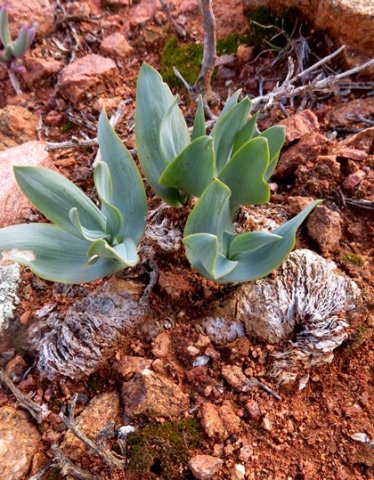Drimia

Author: Ivan Lätti
Photographer: Thabo Maphisa
Drimia is a genus of bulbous perennials, mostly deciduous plants, forming part or previously formed part of the Hyacinthaceae family. The perennial bulbs are ovoid to globose, varying much in size and sometimes forming clumps as in the photo. The bulbs consist of loose scales that overlap each other. The roots under the bulbs are often swollen and branched.
There was a formal name change decision taken in 2016 by the APG (Angiosperm Phylogeny Group) IV, moving Hyacinthaceae entirely into Asparagaceae as the subfamily Scilloideae. This will probably cascade through the botanical literature in due course, meaning that Hyacinthaceae is officially no longer recognized as a separate family. Later South African books do not necessarily show this change yet, for reasons including that it is not legally binding and the people in the plants community are allowed to take their time in absorbing changes, bigger ones more slowly. And, of course, some recent decisions may be expected to be reversed or modified still, as all the evidence supporting them may not yet have fully percolated through the system.
Optional earlier classifications may thus be continued, preventing sudden changes from causing regional confusion among users. Allowing taxonomic conservatism to adapt, should be regarded as temporary, for in the end all recognized plant families should be monophyletic, meaning that they confirm descent from a most recent common ancestor and include all descendants. Formally given scientific plant names are continually brought up to date, in accordance with this principle. This website, mainly serving amateurs, usually follows the SANBI Red List Site in its timing of reflected changes.
Drimias grow one to fifteen leaves annually, usually after flowering or dry at flowering. The leaves are highly variable. In shape they may be terete (cylindrical), linear (narrowly oblong) or strap-shaped. The blades may be hairy or glabrous. The margins may be entire or crisped.
Drimia flowers grow in racemes ranging from cylindrical to shorter and nearly head-like. The flowers have subtending bracts that are spurred, outgrowths on the lower side near the bract bases. Lower flowers in the raceme have larger spurs. The tepals are fused at the base where they form a short tube. Flower colours range from white to pink, yellowish, greenish brown or purple, often tinged silver or bronze. The tepal keels are usually darker. The flowers face outwards or nod. Each flower lasts for about a day.
There are six stamens emerging from the base of the perianth tube. The cylindrical filaments are erect, spreading or nearly together. The anthers open in longitudinal slits. The superior, three-locular ovary is ovoid, housing numerous ovules.
The oblong to ovoid fruit capsule dehisces each of its three locules separately when ripe. The flat, ovate seeds are dark and shiny.
The Drimia genus consists of about 100 species in Africa, the Mediterranean and Asia, about 60 of them in South Africa. The generic name, Drimia, is derived from the Greek word, drimus, meaning stinging, biting or pungent and the word part -ius meaning characteristic of, referring to the irritant and sometimes poisonous plant parts, particularly the sap.
The clump of large-bulbed plants in picture were seen in southern Namaqualand during August. Their broad, grey-green leaves taper to acute tips, the blades longitudinally lined with fine undulations. Three South African Drimia species were found bearing broad leaves somewhat similar to the ones shown here:
Drimia capensis may occur in the area (Manning, 2007) or only in the Eastern Cape (http://redlist.sanbi.org). It clumps, the erect, broad leaves may be shaped roughly as in picture, the colour variable, some similar to what is shown here (iNaturalist).
D. altissima, the tall white squill, previously D. barteri and D. paolii, also housed botanically in Urginea and Scilla in the past, is found from the Western Cape to Limpopo. Its leaves vary from bright green to blue-grey, also in width and the angles at which they are borne.
D. elata, previously D. robusta (and more), is reported in http://redlist.sanbi.org to grow in all provinces but the Western Cape. It has a variety of leaf shapes: some broad but short, some prostrate, others with wavy margins and several in shades of grey. Overlap between D. elata and D. altissima, or a lingering grey area between their identities is likely.
The input given here does not yield a definitive answer. Have fun with the inconsistencies in the reported information. Plant identities are sometimes fraught with mystery and enigma, driving the need for certainty and precision in some people. Answers and mistakes can look so similar when information is incomplete.
Comparing flowers will yield better answers, requiring revisits in the appropriate seasons to the places concerned. An improved answer will arrive here later. Looking elsewhere may be faster. The search belongs to all (Pooley, et al, 2025; Euston-Brown and Kruger, 2023; Manning, 2007; Leistner, (Ed.), 2000; Lowrey and Wright, 1987; Andrew, 2017; iNaturalist; http://redlist.sanbi.org).

